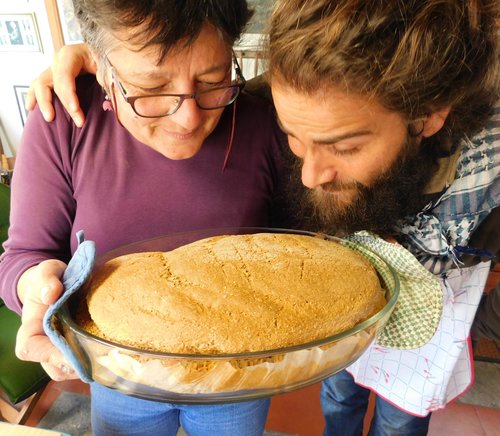Crete, the largest of the Greek islands, is a land rich in history, culture, and culinary traditions. One of the most cherished aspects of Cretan cuisine is its bread. For centuries, bread has been a staple in the Cretan diet, symbolizing sustenance, hospitality, and community. Traditional Cretan bread baking classes offer an immersive experience into this essential aspect of Cretan life, allowing participants to learn age-old techniques, understand the cultural significance of bread, and enjoy the unique flavors of the island.
The Importance of Bread in Cretan Culture
Bread holds a central place in Cretan culture, not just as a dietary staple but also as a symbol of hospitality and celebration. In traditional Cretan households, bread is often made from scratch, using locally sourced ingredients and time-honored methods. Bread is present at every meal, from breakfast to dinner, and is a key element in many religious and festive occasions.
Different types of bread are prepared for various occasions. For example, “Eptazymo,” a seven-leaven bread, is a special type of bread made with a unique fermentation process, often reserved for significant celebrations. “Dakos” is a type of rusk, twice-baked bread, that is a staple in Cretan cuisine, commonly topped with tomatoes, cheese, and olive oil. Learning to make these traditional breads provides insight into the island’s culinary diversity and cultural practices.
The Bread Baking Class Experience
Participating in a traditional Cretan bread baking class is more than just a cooking lesson; it is a cultural journey. These classes are typically held in picturesque settings such as traditional village bakeries, rustic farmhouses, or dedicated cooking schools that emphasize authentic culinary experiences. The classes cater to all levels, from beginners to experienced bakers, and are often led by local bakers who have inherited their skills from previous generations.
1. Ingredients and Preparation:
The first step in a bread baking class is familiarizing participants with the ingredients. Traditional Cretan bread is made using simple, natural ingredients such as flour, water, yeast, salt, and olive oil. Often, the flour is sourced from local mills, ensuring freshness and quality. The use of olive oil, a staple in Cretan cooking, adds a distinctive flavor and texture to the bread.
Participants learn about the different types of flour and their properties, the importance of yeast and fermentation, and the role of olive oil in creating the perfect dough. The instructor explains the significance of each ingredient and how they contribute to the bread’s flavor and texture.
2. Kneading and Shaping:
Kneading is a crucial step in bread making, and traditional techniques are passed down through generations. Participants learn how to knead the dough by hand, developing the right consistency and elasticity. The instructor demonstrates the proper techniques, ensuring that each participant gains hands-on experience.
Once the dough is ready, it is shaped into various forms. Traditional Cretan breads come in different shapes and sizes, from round loaves to braided designs. Shaping the dough is not just a technical process but also an artistic one, reflecting the baker’s skill and creativity.
3. Baking and Cooking Methods:
Baking methods vary, but traditional Cretan bread is often baked in wood-fired ovens. These ovens impart a unique flavor and texture to the bread, creating a crusty exterior and a soft, airy interior. Participants learn how to operate these ovens, including how to control the temperature and maintain the right baking environment.
In addition to baking, participants might also explore other cooking methods, such as making “paximadi,” the famous Cretan barley rusks. These rusks are baked twice, first as a loaf and then sliced and baked again to achieve their characteristic crispness.
4. Tasting and Cultural Insights:
No bread baking class is complete without a tasting session. Participants sample the fruits of their labor, often accompanied by other traditional Cretan foods such as cheese, olives, and local wine. This tasting experience highlights the versatility of Cretan bread and its integral role in the island’s cuisine.
Instructors often share stories and cultural insights, explaining the historical and social contexts of bread in Cretan life. These narratives provide a deeper understanding of how bread has shaped the island’s culinary traditions and community practices.
Benefits of Bread Baking Classes
Engaging in traditional Cretan bread baking classes offers numerous benefits. Participants gain practical skills and knowledge that they can apply in their own kitchens, creating authentic Cretan bread at home. The classes also provide a meaningful connection to Cretan culture, fostering an appreciation for the island’s culinary heritage.
Moreover, these classes promote sustainable and mindful cooking practices. By using local, natural ingredients and traditional methods, participants learn about the importance of sustainability and the value of artisanal craftsmanship.
Conclusion
Traditional Cretan bread baking classes offer a rich and rewarding experience, blending culinary skills with cultural immersion. Participants not only learn the art of bread making but also gain insights into the island’s history, traditions, and way of life. Whether you are a food enthusiast, a cultural explorer, or simply looking for a unique hands-on activity, these classes provide a memorable journey into the heart of Cretan cuisine. Through the simple yet profound act of baking bread, one can connect with the timeless rhythms of Cretan life and enjoy the enduring flavors of the island.


